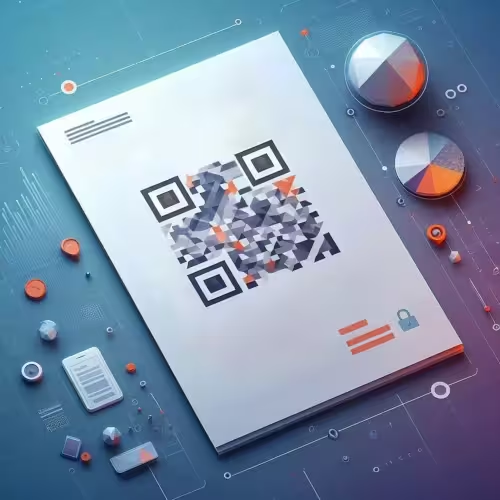Protecting Against Fraud and Tampering with visible digital seal (VDS).
A visible digital seal is a digital certification that provides visible proof of authenticity and integrity for online content, documents, and transactions. VDS is an essential component of maintaining trust and security in the digital world. Displaying a VDS assures your customers that your content is authentic and untampered. The digital seal acts as a unique identifier that verifies the authenticity and integrity of the content. Any attempt to alter or manipulate the content will break the seal, alerting users to potential tampering. This helps to build trust, credibility, and protect against fraud. By implementing VDS technology, you can safeguard your digital assets, such as documents or products from unauthorized modifications. This is particularly important for industries that deal with sensitive information, such as finance, healthcare, and legal sectors.
How it works.
VDS technology.
Visible Digital Seal (VDS) technology enhances document security by embedding a secure, machine-readable code directly onto physical documents. This code, which appears as a 2D barcode or QR code, contains encrypted data that verifies the authenticity and integrity of the document. Generating the VDS involves digitally signing the document’s key information with a cryptographic key, creating a unique digital signature. During verification, the system scans and decrypts the code to extract and validate the embedded information against the original data. This process ensures that any tampering or alterations are immediately detectable, providing a robust and reliable method for securing important documents.
Enhanced Security
VDS technology provides a robust layer of security by embedding encrypted, machine-readable codes on documents, making it easy to detect tampering or alterations and ensuring the authenticity of the document.
Easy Verification
With VDS, the verification process is simplified and efficient. Scanning the 2D barcode or QR code quickly retrieves and validates the document’s information, streamlining authentication procedures and reducing the risk of fraud.
Cost-Effective Implementation
Implementing VDS technology is cost-effective as it integrates seamlessly with existing document issuance and verification systems, eliminating the need for extensive infrastructure changes while significantly enhancing document security
Key Features
Structured Data Set.
Electronically Signed Encoded Data Set.
The VDS contains a payload and its signature from the issuer, forming an Electronically Signed Encoded Data Set (ESEDS). This structured data set includes a header, payload, signature, and an optional auxiliary data block, ensuring comprehensive and secure data representation for each document.
Flexible Representation.
Versatile Machine-Readable Codes.
VDS can be represented in various machine-readable codes (MRCs), such as QR codes, barcodes, or RFID tags. These codes are easily readable using devices like scanners, barcode readers, or RFID readers, offering flexible and accessible solutions for different verification environments and devices.
Efficient Data Utilization.
Optimized Space and Resource Management.
VDS optimizes the use of space by not containing the certificate used for the signature or the definition of the use case directly. Instead, it includes identifiers for their retrieval, ensuring efficient data utilization and reducing the data footprint on the document.
Use Case Specific Implementation.
Customized Secure XML-Format Manifest.
The implementation of VDS is tailored to specific use cases, determining key data fields, field constraints, and additional verification policies. This customization is achieved through a secure XML-format manifest file, which is extendable for additional functionalities, ensuring the solution meets the precise needs of various applications.
Robust Verification Process.
Public Key Infrastructure (PKI) Integration.
The verification of VDS is supported by a robust Public Key Infrastructure (PKI), ensuring the authenticity and integrity of the document. Each element supporting the VDS is cryptographically signed and protected, leveraging PKI to guarantee trustworthiness and secure verification processes.
The Role of the Visible Digital Seal International Council (VDSIC).
The Visible Digital Seal International Council (VDSIC), known in French as the Association Internationale pour la Gouvernance du CEV (AIGCEV), is a leading consortium committed to developing a secure, standardized framework for the deployment of Visible Digital Seals (VDS) across various industries. Bringing together institutional bodies like ANTS and private entities, the VDSIC aims to combat document fraud by promoting the adoption of VDS technology. A key outcome of these efforts is the ISO 22376:2023 standard, which defines the structure, representation, and verification processes necessary for the interoperable use of VDS. The VDSIC also maintains a comprehensive registry of all stakeholders—referred to as trust networks—by country, ensuring transparency and facilitating collaboration among certified entities worldwide.
Understanding Trust Networks in the Visible Digital Seal Ecosystem.
Trust networks form the backbone of the VDS ecosystem, serving as structured communities of stakeholders—including certification authorities, document issuers, and verifiers—who collaborate to establish and maintain the integrity of the Visible Digital Seal. Each trust network operates under a rigorous set of rules and standards set forth by the VDSIC, ensuring that all entities within the network adhere to stringent security protocols and best practices. By categorizing trust networks by country and maintaining a central registry, the VDSIC enables seamless cross-border interoperability and mutual recognition of VDS credentials. This approach ensures that each document issued under a recognized trust network can be verified across international boundaries with confidence. Through trust networks like the Otentik Trust Network, stakeholders can authenticate the origin and legitimacy of certified information, fostering a more secure and transparent global environment for digital document management.
id3 Technologies’ Pioneering Role in the VDS Ecosystem.
As a key contributor to the VDSIC initiative, id3 Technologies has been at the forefront of implementing VDS solutions to enhance the security and interoperability of digital documents. id3 Technologies was the first organization to integrate the Otentik Trust Network, leveraging its advanced BioSeal solution to offer unique use cases that combine VDS technology with biometric authentication. By integrating biometrics into VDS, id3 Technologies provides an additional layer of security that links individuals to their documents with high precision, preventing identity fraud and ensuring that document authenticity can be verified beyond doubt. This pioneering approach positions id3 Technologies as a leader in the development of secure digital identity solutions, contributing to the global adoption of Visible Digital Seals and reinforcing the trust and reliability of certified information across international borders.
Applications
Government and Public Services
Authenticate identification documents, permits, and licenses, providing a reliable method to verify the authenticity of official documents.
Travel and Immigration
Enhance the security of passports and visas, ensuring the authenticity of travel documents and preventing forgery or tampering.
Education and Certification
Secure diplomas, transcripts, and certifications, ensuring that academic credentials are genuine and easily verifiable.
Financial Services
Protect the integrity of financial documents such as checks, contracts, and bank statements, reducing the risk of fraud and ensuring trust in financial transactions.
Reliable technology proven by Compliance with International Standards.
Our Visible Digital Seal (VDS) technology complies with international standards such as ISO 22376 and ISO 22385, demonstrating our commitment to industry best practices and regulatory compliance. ISO 22376 specifies the requirements for the creation and verification of visible digital seals on documents, ensuring that our VDS technology meets the highest standards for security and reliability. ISO 22385 outlines the methods for evaluating the effectiveness of these seals, providing a benchmark for the performance and integrity of our solutions. By aligning with these standards, we ensure that our VDS technology delivers robust, trustworthy, and globally recognized security for document verification.


